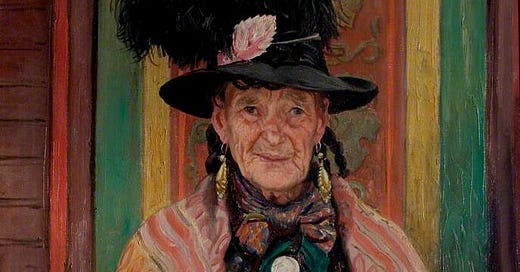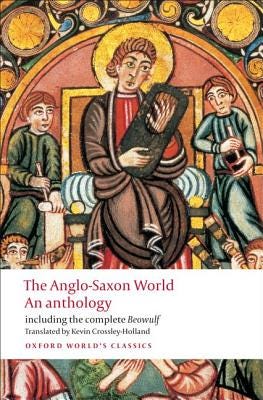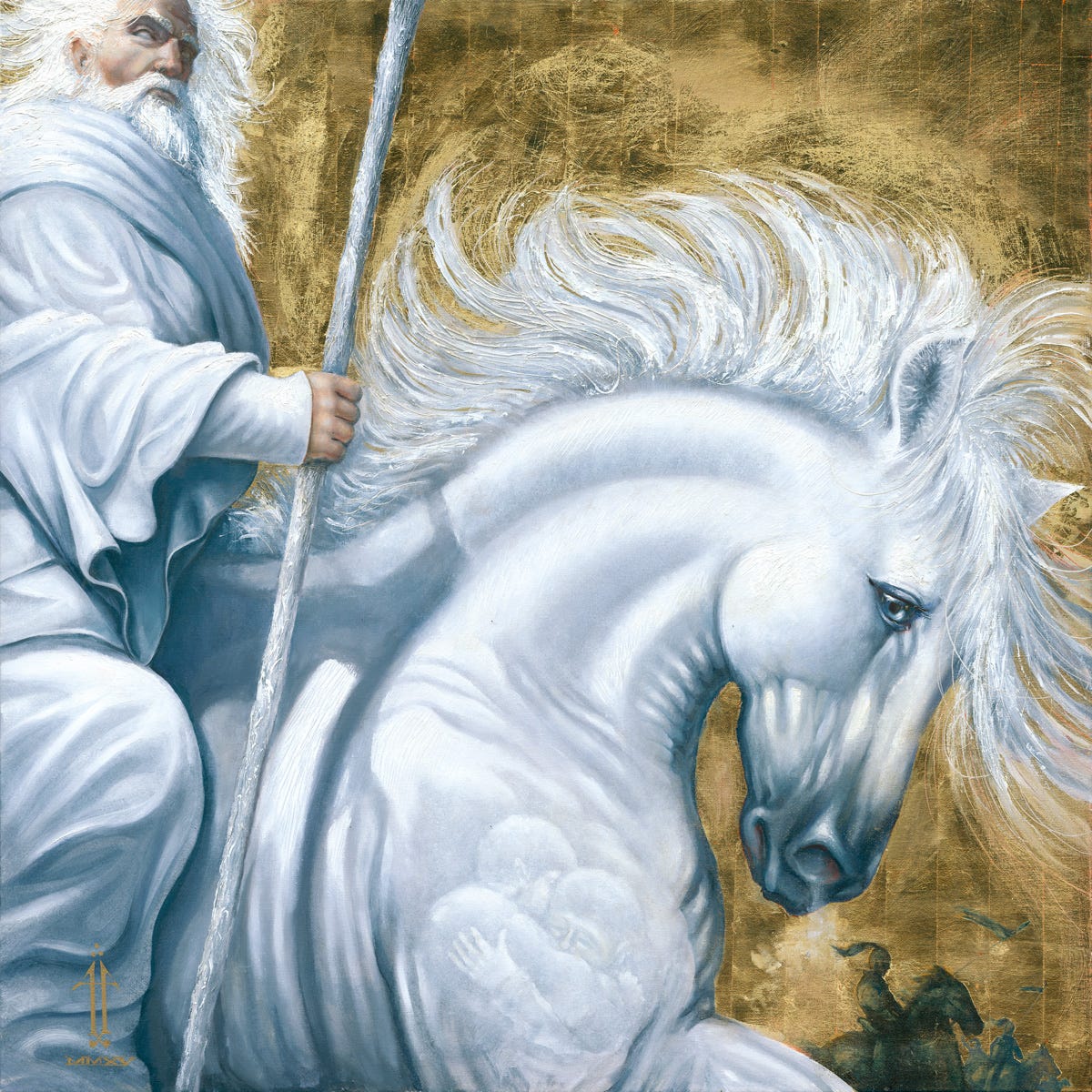Good friends and readers,
The fine dame in the painting above caught my eye. She is regal, serene, with just that twist of mouth and set of feather that suggests a pervasive merriment about her person. I am struck by her sense of pageantry, her pride in the wearing of her finest for some great occasion. She communicates an aura of importance; not self-importance, but a sense of her ‘fine feathers’ as taking part in some meaningful celebration. I think she offers a subtle challenge to all of us bungling about in the modern age. Do we, really, have a sense of the pageantry and drama of our lives?
I’ve been finishing (after almost two-years of happy on-and-off-again reading) Eleanor Porter’s Winters in the World: A Journey Through the Anglo-Saxon World. The book is a survey of the festivals and customs attending the cycle of both the seasons and the church year in Anglo-Saxon England, often with those two themes intertwined. The poetry of the era describing the seasons both of the outer world and of the inner one of soul are astounding in their beauty and in their, well, psychological accuracy. They fully bemoan the hard winters of suffering and yet rejoice in what spring redeems, what summer promises, what all the turning of the earth is always pointing us toward in hope. And they do it all with ritual, liturgy, and high style. They too, have a kind of pageantry to their sense of self and ordinary life, a recognition that their stories participate in a larger story in which they act gallant, faithful, noble (or not) parts. They too enacted festivals and dramas, dressing up, making feasts, in order to honour the drama of the seasons and the great story of the church year, of Christ’s life told over and over again each year in each feast and festival.
I’m planning out my year with the children and in company with this book and painting, marking out days to stop, dress up, engage the great drama, put on our fine feathers and make a feast. Seasonal turnings, saints days, church feasts, family days, we’re going to mark them in high style. And merriment, of course.
Books
I’m on an Anglo-Saxon kick. I’ve ordered Crossley-Holland’s The Anglo-Saxon World: An Anthology. While Winters in the World is a wonder, a compendium of poetry and prose from that rich, imaginative era. Lines like this from The Wanderer struck my curiosity:
Thus this middle-earth
droops and decays every single day;
and so a man cannot become wise, before he has weathered
his share of winters in this world. A wise man must be patient,
neither too hot-hearted nor too hasty with words,
nor too weak in war nor too unwise in thoughts,
neither fretting nor fawning nor greedy for wealth,
never eager for boasting before he truly understands;
a man must wait, when he makes a boast,
until the brave spirit understands truly
where the thoughts of his heart will turn…
or how about these lines from the Anglo-Saxon poem Advent I:
O, you are the Reckoner and the Rightful King,
who keeps the stronghold, revealing life
and the lofty ways to the blessed, withholding
the lovely lanes of desire to those others,
if their deeds are not sufficient.
I’ve also started in on Seamus Heaney’s Beowulf again (with its excellent introduction), and am ordering a book of Anglo-Saxon poetry and Tolkien’s Beowulf and the Critics. I’ll probably be talking about all this reading in one of my BGF episodes, but at the moment, I am rich in that thrumming wonder of sheer curiosity. It’s such joy to just discover something with a student’s vim.
Beauty
Before I show you some new beauty from around my world, I have to tell you something very exciting about last time’s feature: Jay Johnstone, the Tolkien-themed artist I wrote about last time has agreed to give my readers 10% off his artwork. Just use the code NEXTORDER and you should receive the discount on any order you make through his WEBSITE. Which of his prints do you like the most? I’m eyeing a number, including some hobbit prints, Gandalf the White, one of Aragorn, and certainly of Goldberry and Tom Bombadil (some of my favourite characters in The Lord of the Rings.)
For this time, let me tell you about my friend, Tim Steward, an Oxford-based artist whose images are a regular source of beauty in my life. His website is HERE, or you can follow him at Instagram under @timstewardart. I first discovered him through his cityscapes of Oxford. I love both the underlying structure he gives to the buildings, but also the whimsy in the slight lean or curve of the shape he gives, the fluid, impressionist overlay. It captures something of Oxford’s spirit: underlying age in the flux of new seasons, ideas, and weather. I have his print Enveloped in Gold in my study, and am currently greatly enjoying his series of more abstract paintings from his time in Cornwall. Someday I want one of them for the vicarage. The colours bear the brooding moodiness of the sea that moves me deeply. Discover, and I hope you enjoy as I do. (And he does art classes around Oxford if you’re local!)
Theology
In my very brief morning moments between an hour with adorable and very squirmy Elanor and breakfast with the other three, I’ve been snatching at phrases from Alexander Schmemann again in his For the Life of the World. His vision of the world as Eucharistic feast, as humanity as given the particular gift of both receiving the richness of creation and offering it back to God in every aspect of existence is exactly what I need to undergird me amidst my own roiling ordinary. Take, for instance, this passage:
In the Bible the food that man eats, the world of which he must partake in order to live, is given to him by God, and it is given as communion with God. …All that exists is God’s gift to man, and it all exists to make God known to man, to make man’s life communion with God. It is divine love made food, made life of man. God blesses everything He creates and in biblical language, this means that He makes all creation the sign and means of His presence and wisdom, love and revelation: “O taste and see that the Lord is good.”
My working morning draws to a close. My flat white is down to its frothy dregs. The day patters toward noon and my children await me for a lunch of sourdough and strawberries. Summer draws languidly to its close, still gentle and mild, but with that nip in the evenings that turns my heart to a hunger for firesides. It’s still the season of harvest, but I am beginning to gather in… books for study, food for the winter, blankets for our cold house, sweaters for the cold. And in it, I’m aware of the turning of the earth, the seasons of my own heart in its yearning. I’ll leave you with these Anglo-Saxon words from a harvest poem:
Harvest is a joy to men, when God,
holy king of the heavens, causes the earth
to give bright fruits for nobles and the needy.
May the holy king of the heavens bring you bright fruits… and good books too.
With love,
Sarah
PS This post contains affiliate links that may bring me a small profit at no extra cost to you (as I’m sure you’re already aware). All towards building the Vicarage library! Thank you.










The lady in the portrait reminds me of Queenie from Lark Rise to Candleford!
Having only just ‘found’ you and going back through older posts I see we are currently kindred reading spirits. I’m just embarking on Winters in the World and will check out the other books you mention.